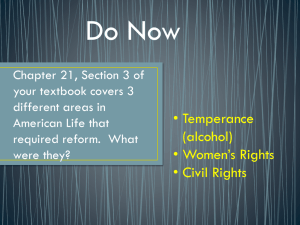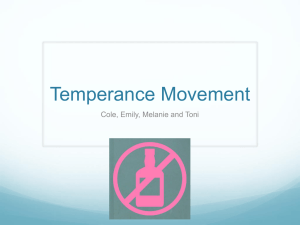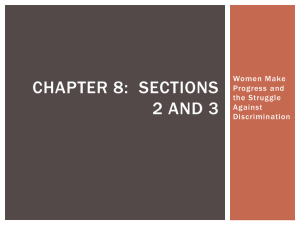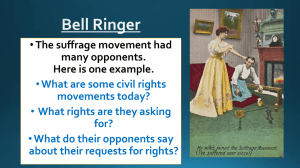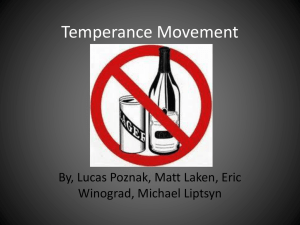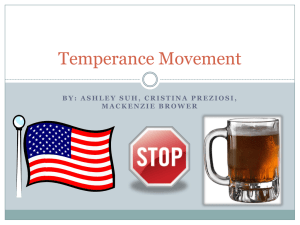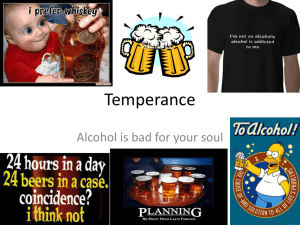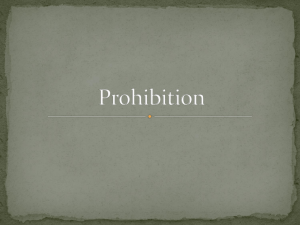Temperance Handout
advertisement
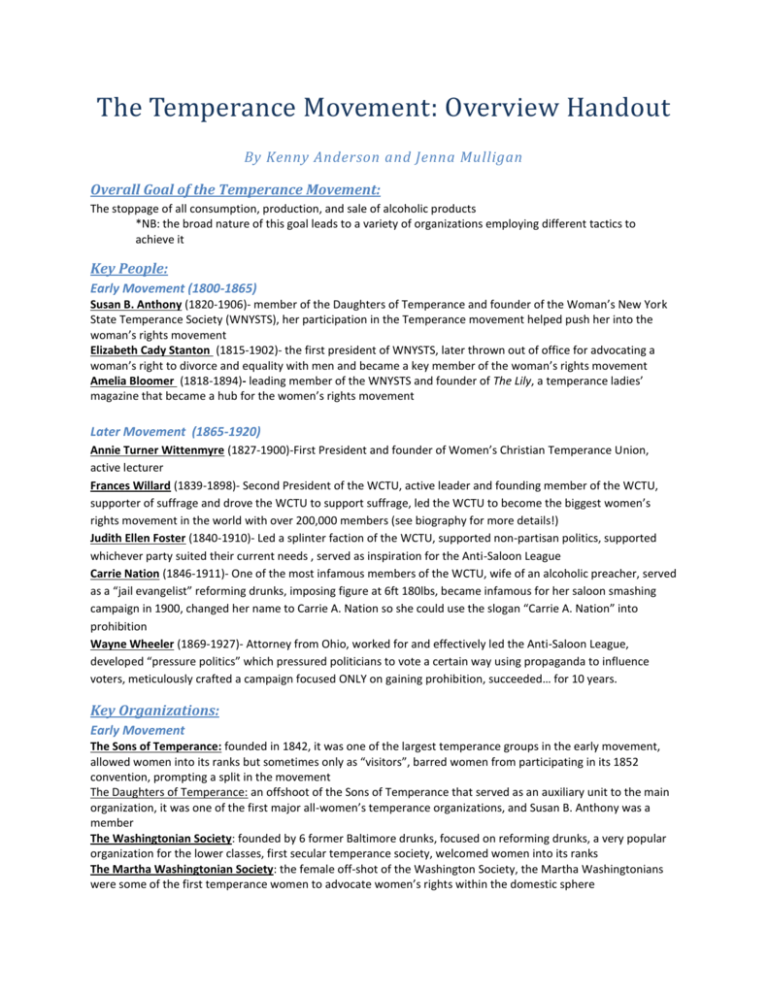
The Temperance Movement: Overview Handout By Kenny Anderson and Jenna Mulligan Overall Goal of the Temperance Movement: The stoppage of all consumption, production, and sale of alcoholic products *NB: the broad nature of this goal leads to a variety of organizations employing different tactics to achieve it Key People: Early Movement (1800-1865) Susan B. Anthony (1820-1906)- member of the Daughters of Temperance and founder of the Woman’s New York State Temperance Society (WNYSTS), her participation in the Temperance movement helped push her into the woman’s rights movement Elizabeth Cady Stanton (1815-1902)- the first president of WNYSTS, later thrown out of office for advocating a woman’s right to divorce and equality with men and became a key member of the woman’s rights movement Amelia Bloomer (1818-1894)- leading member of the WNYSTS and founder of The Lily, a temperance ladies’ magazine that became a hub for the women’s rights movement Later Movement (1865-1920) Annie Turner Wittenmyre (1827-1900)-First President and founder of Women’s Christian Temperance Union, active lecturer Frances Willard (1839-1898)- Second President of the WCTU, active leader and founding member of the WCTU, supporter of suffrage and drove the WCTU to support suffrage, led the WCTU to become the biggest women’s rights movement in the world with over 200,000 members (see biography for more details!) Judith Ellen Foster (1840-1910)- Led a splinter faction of the WCTU, supported non-partisan politics, supported whichever party suited their current needs , served as inspiration for the Anti-Saloon League Carrie Nation (1846-1911)- One of the most infamous members of the WCTU, wife of an alcoholic preacher, served as a “jail evangelist” reforming drunks, imposing figure at 6ft 180lbs, became infamous for her saloon smashing campaign in 1900, changed her name to Carrie A. Nation so she could use the slogan “Carrie A. Nation” into prohibition Wayne Wheeler (1869-1927)- Attorney from Ohio, worked for and effectively led the Anti-Saloon League, developed “pressure politics” which pressured politicians to vote a certain way using propaganda to influence voters, meticulously crafted a campaign focused ONLY on gaining prohibition, succeeded… for 10 years. Key Organizations: Early Movement The Sons of Temperance: founded in 1842, it was one of the largest temperance groups in the early movement, allowed women into its ranks but sometimes only as “visitors”, barred women from participating in its 1852 convention, prompting a split in the movement The Daughters of Temperance: an offshoot of the Sons of Temperance that served as an auxiliary unit to the main organization, it was one of the first major all-women’s temperance organizations, and Susan B. Anthony was a member The Washingtonian Society: founded by 6 former Baltimore drunks, focused on reforming drunks, a very popular organization for the lower classes, first secular temperance society, welcomed women into its ranks The Martha Washingtonian Society: the female off-shot of the Washington Society, the Martha Washingtonians were some of the first temperance women to advocate women’s rights within the domestic sphere Key Organizations (cont’d): The Woman’s New York State Temperance Society: an offshoot of the Daughters of Temperance, broke from the main organization in 1852 when the Sons of Temperance refused to allow women to participate as full members at their annual convention, founded by Elizabeth Cady Stanton, Susan B. Anthony, Amelia Bloomer, and Mary Vaughn, first women’s temperance organization to actively pursue an agenda for women’s rights Later Movement Women’s Crusades: (1873-1874) founded by Eliza Thompson, prayed and sang in saloons to try and convince the owners to stop selling alcohol, motived by religion and moral purity, shut down numerous saloons and started the temperance movement anew Women’s Christian Temperance Union (WCTU): (1874-present) founded and led by Annie Turner Wittenmyre (1874-1879), Frances Willard (1879-1898), and Judith Ellen Foster (splinter faction: 1889-1910), petitions to congress, education about the harms of alcohol, built public water fountains, picketed saloons, campaigned for suffrage, used women’s supposed “moral superiority” as a frame to further the cause of temperance, motivated by religion, moral purity, women’s rights, and eventually suffrage, won victories by getting a hearing in congress to ban liquor, passing federal laws requiring schools to teach children about the dangers of alcohol, building public fountains (alcohol often served as a substitute for unclean drinking water), and shutting down saloons. -Mottos: “Do Everything”, “Smash, Ladies Smash!”, the latter was used by Carrie A. Nation in her infamous saloon smashing campaign Anti-Saloon League (ASL): led by Wayne Wheeler (1893-1927), used “pressure politics” and non-partisanship to influence public opinion to sway Congressmen to vote for temperance laws, a more male-centered organization because of its political nature (only men could vote), motivated by religion and passing prohibition as a law; won victories by securing “dry towns” across multiple states, turning public opinion against alcohol, and finally passing the Prohibition amendment to the Constitution (the 18th Amendment) -Mottos: “The Church in Action Against the Saloon” Influential Events: Early Movement: The Depression of 1837-48: unemployment, and thus, alcoholism peaked, women were especially concerned because they had no right to wages or property within marriage (husband could spend all of her money on drink) and no right to divorce, especially in cases of abuse, garnered increased concern from women about the state of women’s rights within the home, led temperance women to become more active participants in the movement The Passage of the “Maine Law”: passed in 1851 in Maine, forbade the sale of alcohol, it galvanized the movement to try to gain passage of similar laws in other states, also propelled more radical members like Carrie Nation to make sure that the laws were being enforced by authorities and occasionally attacking providers of alcohol themselves, made women realize how little political power they had to make sure changes like this happened The 1852 Convention of the Sons of Temperance: The Sons of Temperance refused to let women participate as full members in their annual convention in New York, led several leaders of the Daughters of Temperance to break off their own society, the Women’s New York State Temperance Society, WNYSTS was the first female temperance society to formally align itself with the beginnings of the women’s rights and women’s suffrage movements Later Movement: (Other key aspects of the later movement are mentioned in Key Organizations and People sections) The Eighteenth Amendment: marks the high point and the end of the Temperance Movement, outlawed the sale, manufacture, and transport of alcohol, but not buying it or drinking it, repealed by the 21st amendment in 1933 after it caused a massive rise in crime due to the bootlegging and smuggling of liquor, considered a massive failure Works Cited Appleby, Joyce Oldham., Eileen K. Cheng, and Joanne L. Goodwin. "Temperance." Encyclopedia of Women in American History. Vol. 2. Armonk, NY: Sharpe Reference, 2002. 199-201. Print. Anderson, Gary L., and Kathryn Herr. Encyclopedia of Activism and Social Justice. Thousand Oaks, CA: Sage Publications, 2007. Print. Bordin, Ruth Birgitta Anderson. Woman and Temperance: The Quest for Power and Liberty, 1873-1900. Philadelphia: Temple UP, 1981. Print. Cayton, Mary Kupiec. "Alcohol and Alcoholism." Encyclopedia of American Social History. Vol. 3. New York: Scribner U.a., 1993. 2136-138. Print. Epstein, Barbara Leslie. "The Woman's Crusade and Home Protection." The Politics of Domesticity: Women, Evangelism, and Temperance in Nineteenth-century America. Middletown, CT: Wesleyan UP, 1981. 89-114. Print. Kerr, K. Austin. Organized for Prohibition: A New History of the Anti-saloon League. New Haven: Yale UP, 1985. Print. Ness, Immanuel. Encyclopedia of American Social Movements. Armonk, NY: Sharpe Reference, 2004. Print. Rappaport, Helen. Encyclopedia of Women Social Reformers. Santa Barbara, CA: ABC-CLIO, 2001. Print. Tyrrell, Iam R. "Women and Temperance in Antebelum America, 1830-1860." Civil War History 28.2 (1982): 128-52. Print.
